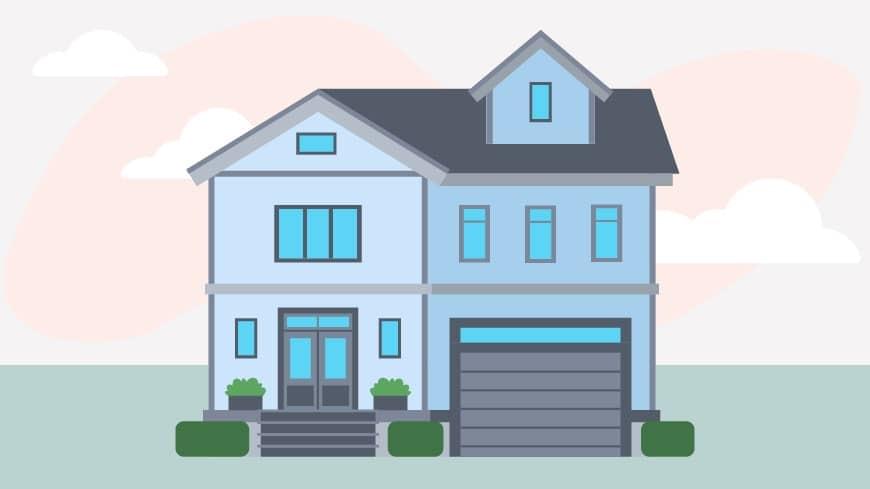What is a Second Mortgage? How Does it Work?

If you’ve built up equity in your home, a second mortgage could be your ticket to turning that value into cash for things that matter most, like renovating your dream kitchen, consolidating debt, or paying for college tuition.
This type of loan gives you access to your home’s equity while keeping your primary mortgage in place, making it a flexible financial tool. But how does it actually work? And how do you know if it’s the right move for you?
In this guide, we’ll cover everything you need to know to make an informed decision. If you’re ready to explore your options, check out Rate's closed-end second mortgage to see how it fits your goals.
What Is a Second Mortgage?
A second mortgage is a loan secured by the equity you’ve built in your home. Unlike your primary mortgage, which was used to purchase your home, a second mortgage doesn’t replace your original loan, it adds a new one.
Since this loan is secondary, your primary lender has the first claim on your property if you default, making the second mortgage riskier for lenders.
The amount you can borrow is based on your equity, which is the difference between your home’s current value and the balance remaining on your primary mortgage. For example, if your home is worth $300,000 and you owe $200,000 on your primary mortgage, you may have $100,000 in equity.
Second mortgages often come with lower interest rates than unsecured loans, like credit cards, because they’re backed by collateral, your home. This makes them a popular option for homeowners who need access to a large chunk of money.
How Does a Second Mortgage Work?
A second mortgage allows you to borrow against your home’s value without refinancing your primary mortgage. The lender offers either a lump sum (as in a home equity loan) or a revolving line of credit (also known as a HELOC). In return, you agree to repay the loan over time, plus interest.
This loan doesn’t replace your original mortgage. Instead, it adds a second payment to your monthly budget, which means you’ll have two separate obligations: your primary mortgage and your second mortgage.
Second mortgages typically have fixed repayment terms, ranging from 5 to 20 years, depending on the lender. Payments usually consist of both principal and interest, and if you don't meet them, it could lead to serious consequences, including foreclosure.
Draw Period vs. Repayment Period: What’s the Difference?
Some second mortgages, especially home equity loans, come with a set repayment schedule right from the start, you borrow a lump sum and start paying it back in fixed monthly installments.
Other loans. like certain home equity lines of credit, have two phases: a draw period and a repayment period. During the draw period, you can access the funds, often making smaller payments. Once the repayment period begins, borrowing ends, and you start paying back both the amount you borrowed (the principal) and interest, typically leading to higher payments.
Understanding how these timelines work can help you pick a second mortgage that fits your budget, both now and in the future.
Requirements for Getting a Second Mortgage
Lenders evaluate several factors before approving a second mortgage. These requirements are designed to gauge your financial stability and ability to repay the loan:
Home Equity
Your home equity is the foundation of a second mortgage. Most lenders require that you have at least 15-20% equity in your home before qualifying for this type of loan. This ensures there’s enough value in your property to cover the loan amount if needed.
Credit Score
Your credit score plays a big role in determining whether you qualify and what interest rate you’ll receive.
A higher credit score can lead to better terms and lower interest rates, so it’s worth checking your credit before applying.
Debt-to-Income Ratio (DTI)
Your debt-to-income ratio compares your monthly debt payments to your income. Lenders use this metric to determine whether you can handle an additional loan payment. A lower DTI, generally below 43%, shows that you’re financially stable and capable of managing more debt.
Are Second Mortgage Rates Higher Than First Mortgage Rates?
Yes, second mortgage rates are usually higher than first mortgage rates. Since the second mortgage lender is second in line for repayment if you default, they take on more risk. To compensate, they charge higher interest rates.
That said, second mortgages often have lower rates than other borrowing options, like credit cards or personal loans. This makes them a more affordable option for homeowners who need to borrow a large amount of money.
Interest rates for second mortgages vary based on your credit score, home equity, and lender policies. To get the most favorable rate available for you, shop around and compare offers from multiple lenders.
Types of Second Mortgages
There are two primary types of second mortgages, each tailored to different financial needs:
Home Equity Loan
A home equity loan provides a one-time lump sum, making it a predictable and straightforward borrowing option. You’ll repay the loan in fixed monthly installments, often with a consistent interest rate.
This stability makes it ideal for significant, one-time expenses like a kitchen remodel, paying off high-interest credit card debt, or covering education costs.
The fixed structure allows borrowers to budget confidently, knowing their repayment schedule won’t change over time. However, since it involves borrowing a specific amount upfront, it's essential to avoid taking on unnecessary debt.
Home Equity Line of Credit (HELOC)
A HELOC is more flexible because it exists as a revolving line of credit that you can draw from during the draw period, which typically lasts 5 to 10 years.
You only pay interest on the amount you borrow, offering versatility for ongoing or unexpected expenses like medical bills or home repairs. Once the draw period ends, the repayment phase begins, more than likely with variable interest rates.
This makes HELOCs a better fit for borrowers who need access to additional funds over time rather than all at once. However, this flexibility can lead to overspending, so it's important to stay on top of your repayment plan.
What Are the Alternatives to a Second Mortgage?
If a second mortgage doesn’t align with your financial goals, there are other ways to access your home’s equity or secure cash:
Cash-Out Refinancing
This option replaces your existing mortgage with a new one that has a larger loan amount. The difference between the two loans is paid to you in cash, which can be used for different reasons.
It’s a good choice if you’re looking to refinance into a lower interest rate or better loan terms while accessing equity.*
Personal Loans
These unsecured loans don’t require equity but typically come with higher interest rates than second mortgages. They can be useful for borrowers without enough home equity or those looking for shorter-term financing.
Credit Cards
While convenient for smaller expenses, credit cards often carry high-interest rates. They’re typically ideal for short-term needs or emergencies, but carrying a balance can become costly over time.
Each alternative has its pros and cons, so it’s important to review your financial situation and long-term goals before making a decision.
Second Mortgage vs. Refinance
Second mortgages and refinancing serve different purposes, even though both allow you to access your home’s equity.
A second mortgage, such as a home equity loan or HELOC, adds an additional loan to your existing mortgage. This option lets you tap into equity without altering the terms of your original loan.
Refinancing, on the other hand, replaces your current mortgage with a new one, often with a larger loan amount to include cash-out funds.
It’s a popular choice for homeowners looking to get a lower interest rate or switch from an adjustable-rate mortgage to a fixed-rate one. However, refinancing involves closing costs and requires resetting your mortgage term, which could extend the time it takes to pay off your home.
When deciding between the two, consider your current mortgage terms, financial needs, and whether you’re comfortable with taking on an additional monthly payment.
Can I Pull Equity Out of My House Without Refinancing?
Yes! A second mortgage is one of the most common ways to access your home’s equity without refinancing.
Both home equity loans and HELOCs allow you to borrow against your home’s value while leaving your original mortgage untouched. This can be especially beneficial if you’ve locked in a low interest rate on your primary mortgage or don’t want to restart your loan term.
Second mortgages give homeowners the flexibility to leverage their equity without disrupting their current loan structure. Whether you’re looking for a lump sum or a line of credit, these options make it possible to use your home’s value to meet your financial needs.
Pros and Cons of a Second Mortgage
Second mortgages can be a smart financial solution, but like any home loan, they come with both advantages and risks. Let’s take a closer look to help you weigh your options.
Pros
Lower Interest Rates Than Credit Cards
If you need cash, second mortgages typically offer significantly lower interest rates compared to credit cards or personal loans, making them a more affordable borrowing option.
Potential to Borrow a Huge Sum of Cash
Since second mortgages are based on your home’s equity, you can access larger amounts of money, which is ideal for major expenses like remodeling, medical bills, or consolidating debt.
You Can Use Them for Anything
Unlike some loans that come with restrictions, funds from a second mortgage can be used for virtually any purpose, from education to starting a business.
Convenient Withdrawal Options for Your Needs
Whether you prefer a one-time lump sum or a flexible line of credit, second mortgages offer options that can work for different financial needs.
Access to Your Equity
A second mortgage lets you tap into your home’s value without selling it, preserving your ownership while giving you liquidity.
Cons
While the advantages are appealing, it’s important to consider the potential downsides:
Higher Interest Rates Than Refinancing
Second mortgages usually come with slightly higher interest rates compared to refinancing, as they carry more risk for lenders.
Two Mortgage Payments
Managing payments for both your primary mortgage and a second mortgage can strain your monthly budget.
Could Put Your Home on the Line
Because your home acts as collateral, if you can't repay a second mortgage you could foreclose on your home, putting your home at risk.
How to Get a Second Mortgage
A second mortgage can be a powerful financial tool, but it’s not for everyone. If you’re considering this option, make sure you weigh the pros and cons and explore all your alternatives.
And if you’re ready to take the next step, check out Rate’s closed-end second mortgage for a smart and straightforward way to unlock your home’s potential!
*Using funds from a Cash-out Refinance to consolidate debt may result in the debt taking longer to pay off as it will be combined with borrower’s mortgage principle amount and will be paid off over the full loan term. Contact Rate, Inc. for more informatio




